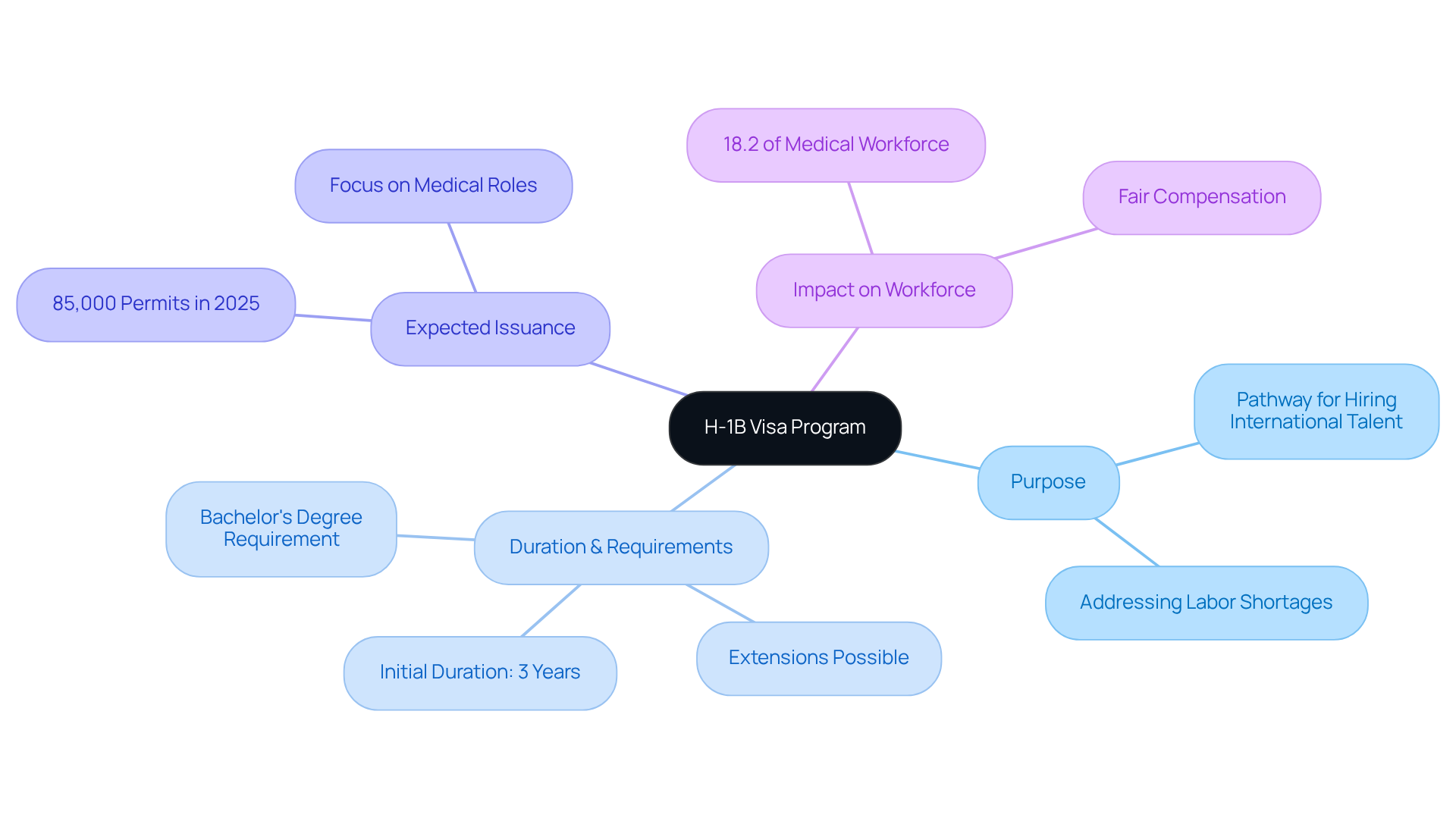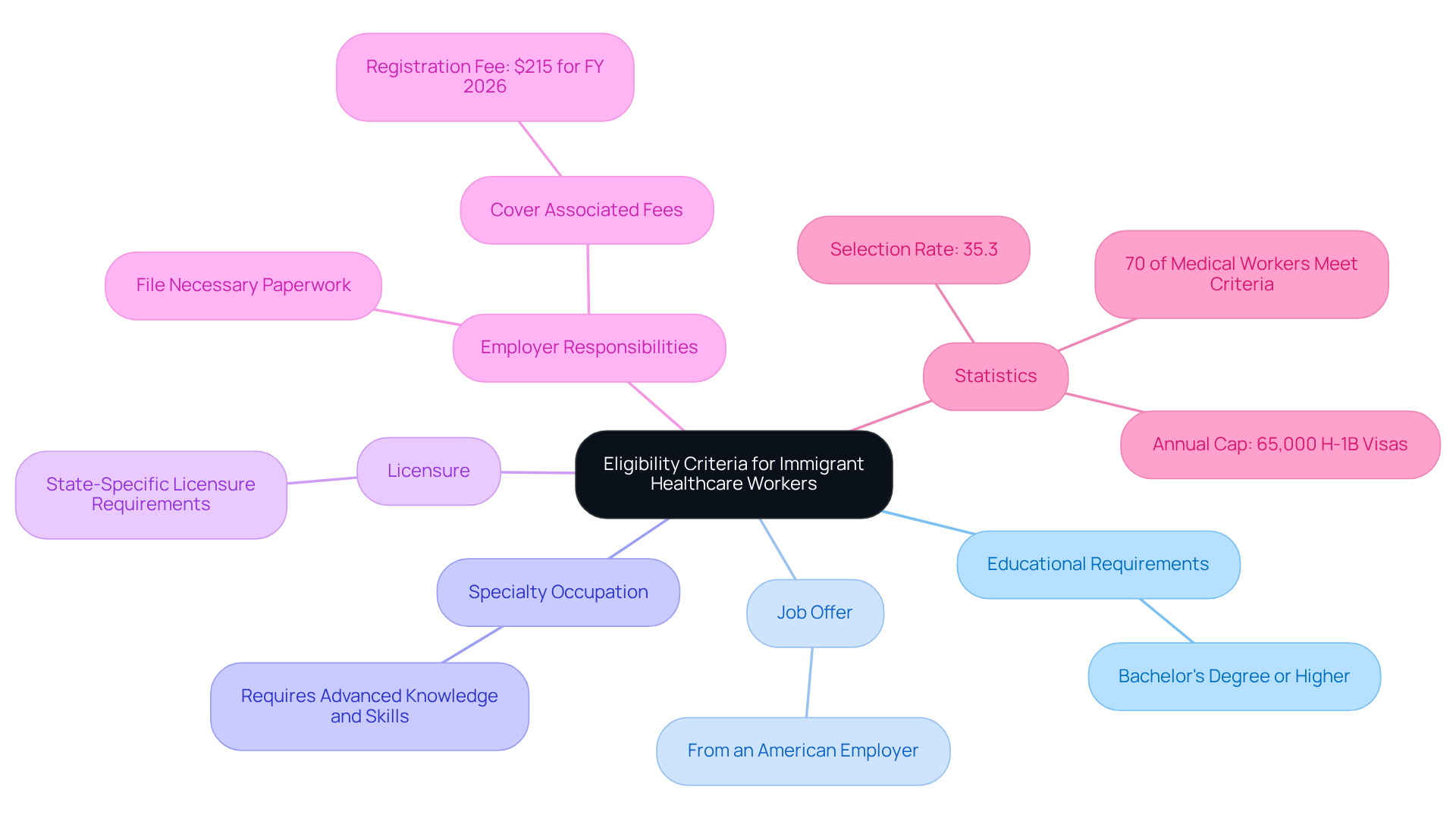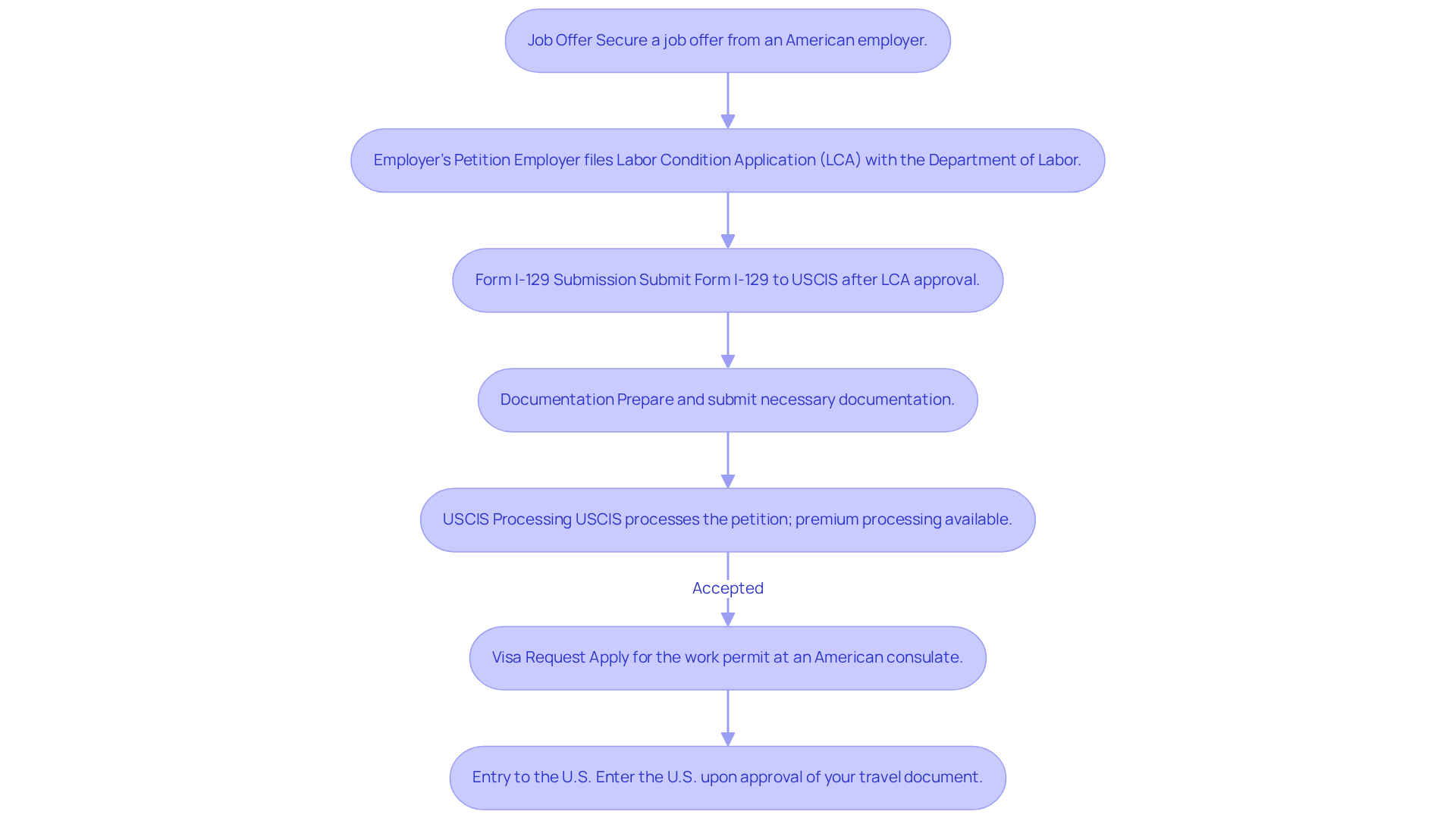Overview
The latest updates on the H-1B visa program reveal significant changes that deeply affect immigrant healthcare workers. A new $100,000 fee for employers sponsoring international employees is now in place. This financial burden could deter medical organizations from hiring the foreign talent they need, further worsening the already critical labor shortages in the U.S. healthcare system. Many employers, particularly in underserved areas, may find it increasingly challenging to absorb these costs.
We understand how overwhelming this situation can feel. It’s crucial to know that you have rights and support in this fight.
Introduction
The H-1B visa program stands as a vital gateway for U.S. healthcare employers eager to access the global talent pool, especially in light of the persistent labor shortages in the medical field. This article explores the latest updates impacting immigrant healthcare workers, emphasizing the significant ramifications of new policies, including a substantial $100,000 fee for employers. As the landscape evolves, one crucial question emerges: how will these changes shape the future of healthcare staffing and the opportunities available for international medical professionals?
Overview of the H-1B Visa Program
The program stands as a vital pathway for U.S. firms seeking to hire international talent in specialized fields, particularly in the medical sector. This non-resident permit is crucial for foreign medical professionals who aspire to fill roles requiring specialized knowledge and skills, effectively addressing significant labor shortages in the industry. Notably, this work permit offers a maximum initial duration of three years, with opportunities for extensions, and mandates that the position requires at least a bachelor's degree or higher in a relevant field.
In 2025, approximately 85,000 work permits are expected to be issued, with a substantial portion allocated for medical roles. According to the latest h1b news, recent updates indicate that nearly half of new visa approvals are granted to individuals already residing in the country, highlighting a trend aimed at retaining skilled workers.
Successful applications within the medical field illustrate the program's effectiveness in meeting workforce demands, especially as immigrant medical professionals constitute 18.2% of the American medical workforce. This work permit not only facilitates employment but also ensures that international workers receive , making it an essential tool in addressing the ongoing challenges within the U.S. healthcare system.

Recent Changes: $100,000 Fee and Its Implications
Recent updates to the work authorization program have introduced a significant fee of $100,000 for employers looking to sponsor international employees. This fee aims to address the and ensure that employers support a system that benefits immigrant workers. For medical employers, this financial burden may heavily influence hiring decisions, potentially deterring them from pursuing H-1B sponsorship. Statistics show that many medical organizations, especially in underserved regions, may struggle to absorb this additional cost, exacerbating existing provider shortages. Over 76 million Americans live in areas designated as having a shortage of primary care doctors, underscoring the urgency of addressing this issue.
International Medical Graduates (IMGs), who are vital to the U.S. physician workforce, may see their job prospects affected by this new fee. The American Medical Association has warned that the fee could limit the availability of highly skilled doctors, particularly in rural areas where access to medical services is already a challenge. Employers who cannot rely on National Interest Exceptions (NIEs) must either pay the fee upfront or hire domestically, which often falls short for many specialties. The NIE process is known to be slow and administratively burdensome, complicating staffing for residency and fellowship programs.
Case studies indicate that major medical systems are reassessing their hiring strategies due to these changes. For instance, some organizations are accelerating Green Card sponsorship to retain global talent amid these policy hurdles. It is advisable for immigrant medical workers to discuss the financial implications of the new fee with potential employers during the hiring process, ensuring clarity and alignment on expectations. Furthermore, it is essential to recognize that many organizations may not be able to cover the application costs for permits, limiting the talent pool in the medical field. This proactive approach can help navigate the complexities introduced by the recent changes in immigration policy.

Eligibility Criteria for Immigrant Healthcare Workers
To qualify for the work visa, immigrant medical professionals face specific eligibility criteria that can feel overwhelming. First and foremost, candidates must hold a relevant bachelor's degree or higher in their field, along with a job offer from an American employer. The position needs to be classified as a specialty occupation, requiring advanced knowledge and skills. For example, a nurse must possess a nursing degree and the appropriate licensure to practice in their state of employment.
It's essential for applicants to ensure their employer is ready to file the necessary paperwork and cover the associated fees, which have recently risen to $215 per registration for FY 2026. Understanding these requirements is vital for medical professionals navigating the visa application process.
Importantly, recent data reveals that about 70% of medical workers meet these eligibility criteria, underscoring their essential role in the U.S. medical system. Immigration lawyers emphasize that thorough preparation and aligning qualifications with job requirements are crucial for successful work permit applications for immigrant healthcare professionals.
With the set at 65,000 and a selection rate of approximately 35.3%, the competition for these permits is fierce. This reality makes it even more critical for applicants to present strong qualifications. Remember, you’re not alone in this fight; we’re here to guide you every step of the way.

Step-by-Step Application Process for H-1B Visa
Navigating the work permit application process can feel overwhelming, but understanding each step is crucial for success. Here’s a practical guide to help you through it:
- Job Offer: First, secure a job offer from an American employer who is ready to support your work authorization.
- Employer's Petition: Your employer must file a Labor Condition Application (LCA) with the Department of Labor, ensuring the wage offered meets or exceeds the prevailing wage for the position. This is a vital step, as the Department typically processes the LCA in about seven days.
- Form I-129 Submission: Once the LCA is approved, your employer will submit Form I-129, Petition for a Nonimmigrant Worker, to the U.S. Citizenship and Immigration Services (USCIS).
- Documentation: Prepare and submit all necessary documentation, including proof of qualifications, a job description, and evidence of your employer's financial stability.
- USCIS Processing: After submission, USCIS will process the petition, which may take several months. If you need a quicker response, premium processing is available for an additional fee of $2,500, guaranteeing a decision within 15 calendar days.
- Visa Request: If your petition is accepted, you must apply for the at an American consulate or embassy, providing any additional documentation required.
- Entry to the U.S.: Upon approval of your travel document, you can enter the U.S. and begin your employment.
Each step is critical, and meticulous attention to detail is essential to avoid delays or denials. Many successful applicants emphasize the importance of thorough preparation and a clear understanding of the process. For example, the case of N.B. illustrates the complexities of the work permit process; he faced significant obstacles but ultimately obtained his authorization through relentless effort. As immigration specialist Daniel Kwik notes, 'Understanding the nuances of the visa application can significantly influence your chances of success.'
It's also important to remember that the standard limit for work permits is 65,000, with an additional 20,000 permits available for candidates holding advanced degrees from U.S. institutions. The registration window for the 2025-26 season is open from March 7 to March 24, 2025.
In summary, navigating the H-1B visa application process while staying updated with the latest h1b news requires careful planning and a thorough understanding of each step involved. Remember, you’re not alone in this fight; we’re here to support you every step of the way.

Conclusion
In summary, the H-1B visa program is a vital pathway for immigrant healthcare workers seeking employment in the United States. This visa addresses the urgent labor shortages in the medical sector and allows skilled professionals to make meaningful contributions to our healthcare system. With the expected issuance of 85,000 work permits in 2025, it is crucial for healthcare professionals to stay informed about the evolving landscape of this program.
Key updates include:
- A new $100,000 fee for employers sponsoring international workers, which could create challenges for hiring in the medical field, especially in underserved areas.
- Understanding the eligibility criteria and the application process is essential for preparation. With 70% of medical workers meeting these criteria, competition is fierce, making it vital for applicants to present strong qualifications.
Ultimately, the importance of the H-1B visa program is immense. It facilitates the entry of talented healthcare professionals into the U.S. and plays a crucial role in meeting the healthcare needs of our population. As changes continue to unfold, it is imperative for both employers and immigrant workers to navigate these complexities with diligence and proactive strategies, ensuring that our healthcare system is adequately supported by skilled professionals. Remember, we’re in this fight together—your future matters to us.
Frequently Asked Questions
What is the H-1B Visa Program?
The H-1B Visa Program is a non-resident permit that allows U.S. firms to hire international talent in specialized fields, particularly in the medical sector.
Who benefits from the H-1B Visa Program?
The program primarily benefits foreign medical professionals who seek to fill roles requiring specialized knowledge and skills, addressing labor shortages in the industry.
What is the maximum duration for an H-1B Visa?
The H-1B Visa offers a maximum initial duration of three years, with opportunities for extensions.
What educational requirements must be met for H-1B Visa positions?
The position must require at least a bachelor's degree or higher in a relevant field.
How many H-1B work permits are expected to be issued in 2025?
Approximately 85,000 work permits are expected to be issued in 2025, with a significant portion allocated for medical roles.
What recent trend has been observed in H-1B visa approvals?
Nearly half of new visa approvals are granted to individuals already residing in the country, indicating a trend aimed at retaining skilled workers.
What percentage of the American medical workforce is made up of immigrant medical professionals?
Immigrant medical professionals constitute 18.2% of the American medical workforce.
How does the H-1B Visa Program contribute to the U.S. healthcare system?
The program facilitates employment for international workers while ensuring they receive fair compensation, helping to address ongoing challenges within the U.S. healthcare system.


